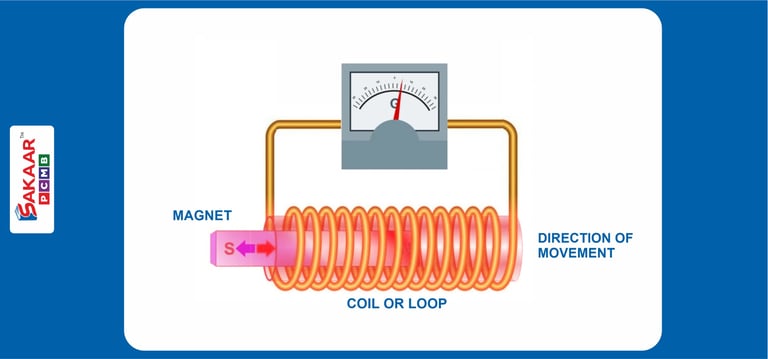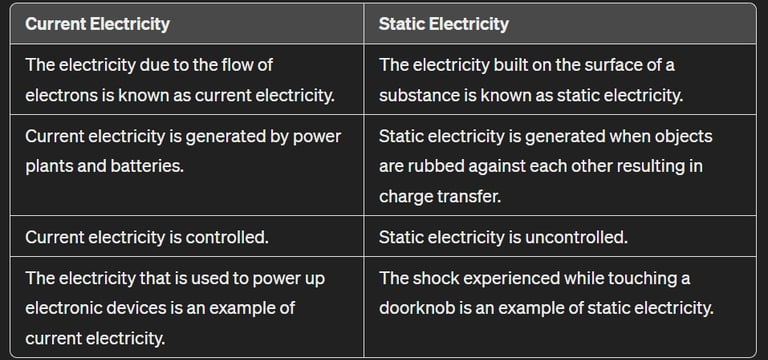Current Electricity

The discovery of current electricity stands as a cornerstone in the history of inventions, significantly enhancing the ease of human life. Credited with this monumental discovery is Benjamin Franklin, whose pioneering work has laid the foundation for our modern dependence on electricity.
Table of Contents
Introduction to Current Electricity
Understanding Electromotive Force (EMF) and Voltage
Types of Current Electricity
Direct Current (DC)
Alternating Current (AC)
Generation of Current Electricity
Relative Motion Between Magnetic Field and Coil
Current Electricity versus Static Electricity
Exploring Static Electricity
Frequently Asked Questions (FAQs)
What Is Current Electricity?
Current electricity is defined as the flow of electrons from one section of the circuit to another.
Electromotive Force (EMF) and Voltage:
When two bodies at different potentials are connected by a conductor, free electrons flow from the higher potential to the lower potential until equilibrium is reached, halting the current flow. As long as a potential difference exists across a conductor, current will flow.
From this analogy, we can define electromotive force and voltage as follows:
Electromotive Force Definition:
Electromotive force is the electrical potential produced by either an electrochemical cell or by changing the magnetic field.
Voltage Definition:
Voltage is the electric potential difference between two points.


Join Best Learning Program....




Frequently Asked Questions – FAQs
Q1: What is current electricity in Physics?
Current electricity refers to the flow of electrons in an electric circuit from one place to another.
Q2: How is current electricity different from static electricity?
Charges continually flow in a kind of electricity known as current. Static electricity is static in contrast to current electricity, which is dynamic.
Q3: How does current electricity work?
Current electricity is the constant flow of electrons. Electrical energy is transported from one point to another in a circuit by the motion of electrons.
Q4: Do circuits use static or current electricity?
Circuits use current electricity.
Q5: Who discovered current electricity?
Benjamin Franklin discovered current electricity.
Direct Current (DC):
Direct current flows steadily in one direction from high to low electron density areas.
DC is extensively utilized in household appliances and battery-powered devices.
Alternating Current (AC):
Alternating current changes direction periodically, enabling a bidirectional flow of charge.
This oscillation is facilitated by sinusoidal variations in current and voltage, resulting in a periodic reversal of current flow.
AC is the predominant form of electricity supplied to residential and industrial electrical systems.
Types of Current Electricity
There are two types of current electricity as follows:
Direct Current (DC)
Alternating Current (AC)
Electromagnetic Induction:
By moving a metal wire through a magnetic field, both alternating current (AC) and direct current (DC) can be generated.
This process exploits Faraday's law of electromagnetic induction, where a changing magnetic field induces an electromotive force (EMF) in a conductor, resulting in the generation of electricity.
Generators and alternators commonly employ this method to produce electricity on a large scale.
Chemical Reactions in Batteries:
Current electricity, specifically direct current (DC), can be generated through chemical reactions in batteries.
Batteries convert chemical energy into electrical energy through redox reactions occurring within their cells.
The flow of electrons from the negative to the positive terminal of the battery creates a direct current, which can power various devices and systems.
These methods provide essential sources of current electricity for a wide range of applications, from powering electrical grids to operating portable electronic devices.
Generation of Current Electricity
Relative Motion Between Magnetic Field and Coil:
It's important to emphasize that for current electricity to be generated through the relative motion between a magnetic field and a coil, this setup must be integrated into an electric circuit. Without a closed circuit, electrons would have nowhere to flow, and the generation of current electricity would not occur.


The direction of the current through the wire is determined by the relative alignment of the magnetic field and the wire's direction.
Current Electricity vs Static Electricity:
In this section, we'll explore the distinction between current electricity and static electricity:
Static Electricity: Static electricity pertains to the accumulation of electric charges on the surface of materials or substances. These charges remain stationary until they are discharged or grounded. This type of electricity is generated through friction. Essentially, static electricity occurs when positive and negative charges become separated.


